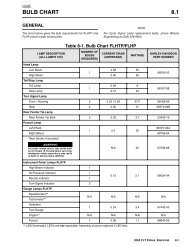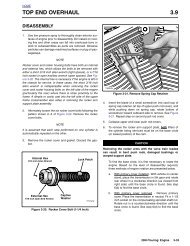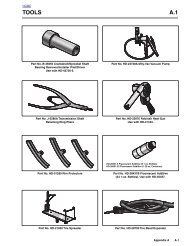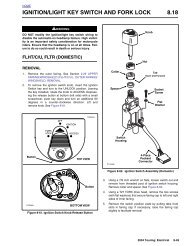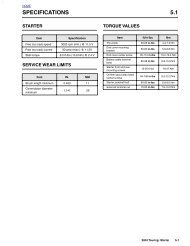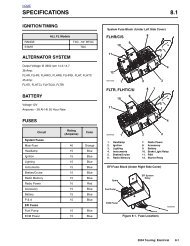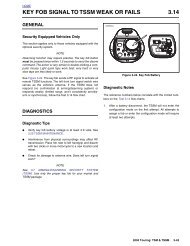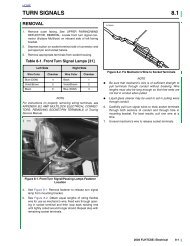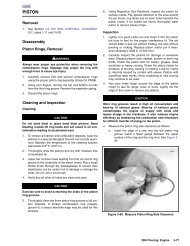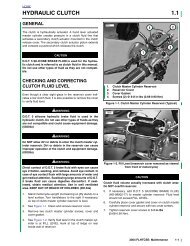7.5 clutch release cover - harley-davidson-sweden.se
7.5 clutch release cover - harley-davidson-sweden.se
7.5 clutch release cover - harley-davidson-sweden.se
- No tags were found...
Create successful ePaper yourself
Turn your PDF publications into a flip-book with our unique Google optimized e-Paper software.
HOMETRANSMISSION POWER FLOW 7.2GENERALSee Figure 7-1. The 5-speed transmission consists of twoparallel shafts supporting five gears each. The longer, ormainshaft, also supports the <strong>clutch</strong> and <strong>se</strong>rves as the inputshaft. The shorter shaft is called the countershaft.Each gear on the mainshaft is in constant mesh with a correspondinggear on the countershaft. Each of the<strong>se</strong> five pairsof gears makes up a different speed in the transmission.The transmission gears are divided into two types, gears thatare splined and rotate with the shaft, and freewheeling gearsthat ride on bearings and spin freely on the shaft. A splinedgear always meshes with a freewheeling gear. Also, three ofthe splined gears are able to slide sideways on the shaft.The<strong>se</strong> sliding gears are u<strong>se</strong>d to change transmissionspeeds. The projections (or dogs) on the sides of the slidinggears, engage dogs on adjacent freewheeling gears, transmittingpower through the transmission.4th GearThe shift into fourth is made when mainshaft 2nd is di<strong>se</strong>ngagedfrom mainshaft 3rd and mainshaft 1st engages mainshaft4th, locking it to the mainshaft.5th GearThe shift from fourth to fifth gear occurs when mainshaft 1stis shifted out of mainshaft 4th, and mainshaft 2nd is shifteddirectly into the main drive gear. Mainshaft 2nd lock the maindrive gear to the mainshaft resulting in a direct one-to-onedrive ratio from the <strong>clutch</strong> to the sprocket.Gear shifting is accomplished by three forks which fit intogrooves machined into the hubs of the three sliding gears.The position of the shifter forks is controlled by a drumshapedshifter cam located on the top of the transmission.NeutralPower is introduced to the transmission through the <strong>clutch</strong>. Inneutral, with the <strong>clutch</strong> engaged, the mainshaft 1st and 2ndgears are rotating, but no power is transferred to the countershaftsince countershaft 1st and 2nd are freewheeling gears.1st GearWhen the transmission is shifted into first gear, countershaft3rd, which rotates with the countershaft, engages countershaft1st, which has been spinning freely on the countershaftdriven by mainshaft 1st.Now countershaft 3rd is no longer freewheeling, but locked tothe countershaft causing the countershaft and countershaft5th to turn. Countershaft 5th transmits the power to the maindrive gear and the sprocket.2nd GearSecond gear is engaged when countershaft 3rd is shifted outof countershaft 1st and engages countershaft 2nd. This lockscountershaft 2nd to the countershaft to complete the powerflow as shown.3rd GearTwo shifter forks are u<strong>se</strong>d to make the shift from <strong>se</strong>cond tothird. One fork moves countershaft 3rd out of countershaft2nd to its neutral position, while another fork engages mainshaft2nd with mainshaft 3rd. This locks mainshaft 3rd to themainshaft to complete the power flow as shown.2004 Touring: Transmission 7-3



